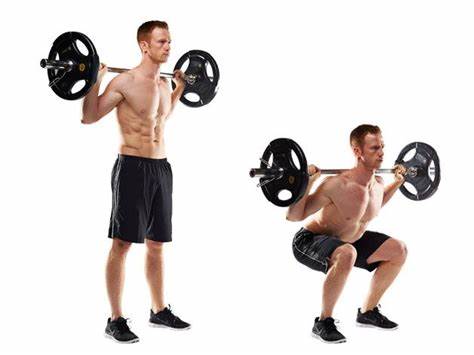BACK SQUAT
The Back Squat is a lower-body exercise that strengthens the glutes, hamstrings and quads. It’s often referred to as “the king of all exercises” due to its ability to build strength, power and size. Place the barbell behind your neck—retract your shoulder blades tightly and rest the bar in the meat of your upper traps. Place your feet between hip and shoulder width with the toes turned out so that at full depth each thigh and the corresponding foot are in line with each other. Set your back in a complete arch, take in a large breath, and lock it in, forcefully tightening all trunk musculature. The back squat requires the structures of the lower body and core to work synergistically. Optimal performance requires an adequate range of motion at the ankles, hips, and knees; superior lower-body strength; and a tremendous amount of core stability. Before you grab your barbell and drop down as low as you can go, take note that it's extremely important to pay attention to the subtleties of the movement here. You're not just bending your knees and letting the load take you down to the floor—their are other important cues you have to remember to do the squat correctly, especially once you start working with heavy weight. Whether you prefer to gain lean muscle mass, bulk up or simply want to get in better shape, a squat is one of the most effective exercises a man can do for these purposes. The benefits of squats for men include injury resilience, strength in lower limbs and better functional movement patterns.

When done improperly, the Back Squat can be highly dangerous and increase your susceptibility to a knee or back injury. When done correctly, it’s a safe exercise that will undoubtedly make you a better athlete. The back squat is the most effective exercise in weightlifting for building basic strength, particularly of the legs and trunk. It is used for general leg strength development primarily, although nearly always is used in combination with the front squat for weightlifting. Squat benefits for guys also includes bettering movement patterns for running and jumping and completing everyday tasks, such as carrying heavy objects and lifting. Traditionally, the most commonly taught squat stance is with your feet shoulder-width apart and feet at a slight outward angle. This stance may work for many people, but it fails to account for individual anatomy differences. There are a huge number of possibilities when it comes to programming the back squat. Most commonly weightlifters will use sets of 1-5 reps, but it’s not unheard of to use as many as 10 occasionally, briefly and far out from competition. The Strength and Conditioning Journal recommends descending until the top of the thigh is at least parallel with the ground and the hip joint is level or a little below the knee joint. Proper ascending is achieved through extension of the hips, knees and ankles until you've returned to the starting position. 먹튀검증디비
